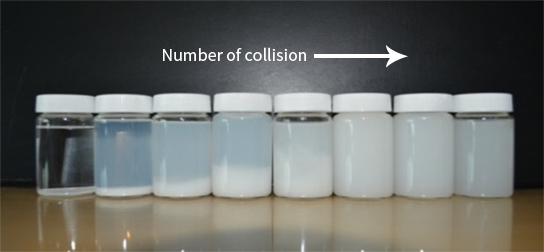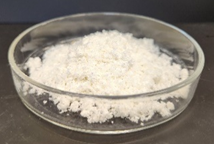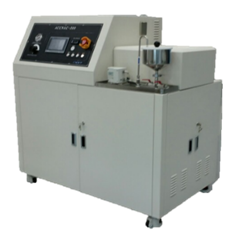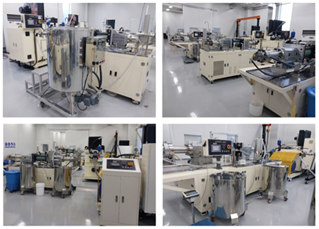CNF production
Aqueous Counter Collision System (ACC system)
Pulp (suspension) is sprayed at high pressure through opposing nozzles inside the chamber and collides with each other, and the weak hydrogen bonds between fiber tissues are separated by the force of water penetrating into the fibers, thereby promoting micronization.

This process involves a homogenization process in which weak hydrogen bonds between fiber molecules are broken by repeated collision energy between fluids, enabling the production of high-quality cellulose nanofibers free of impurity contamination.

| Type of Bond | Bonding Energy(kJmol-1) |
|---|---|
| Medium hydrogen bond | 21-62 |
| Weak hydrogen bond | 0.42-4.2 |
| London dispersion force | 2 |
| Dipole-dipole | 0.6-2 |
Manufacturing of Cellulose NanoFiber(CNF)
Manufacturing of Cellulose NanoFiber(CNF)
CNF Suspension
| Type of Bond | Low | High | U-High |
|---|---|---|---|
| Crystallization (%) | 64 ~ 67 | ||
| Transmittance (600nm) |
~15~ | ~35~ | ~70~ |

Modified CNF Powder
| Tab density, g/cm3 | ~0.2~ |
|---|---|
| Particle size/d(0.5), ㎛ | 1mm |
| Water, % | 3% less |

ACCNAC-300
ACCNAC-300

| Model | Process Output | Nozzle Diameter | Pressure Range | Elec’Cap. | Size | Weight |
|---|---|---|---|---|---|---|
| L/hour | ㎛ | MPa | kW | mm | Kg | |
| ACC-300 | 20~30 | 140~200 | 140~200 | 9 | 1480(L)x900(W)x1510(H) | 860 |
ACC-1000/2000
ACC-1000/2000

| Model | Process Output | Nozzle Diameter | Pressure Range | Elec’Cap. | Size | Weight |
|---|---|---|---|---|---|---|
| L/hour | ㎛ | MPa | kW | mm | Kg | |
| ACC-300 | 20~30 | 140~200 | 140~200 | 9 | 1480(L)x900(W)x1510(H) | 860 |
| ACC-1000/2000 | 500 | 450~ | 200 | 150 | - | - |
* Marked for non-sale OEM/ODM mass production
